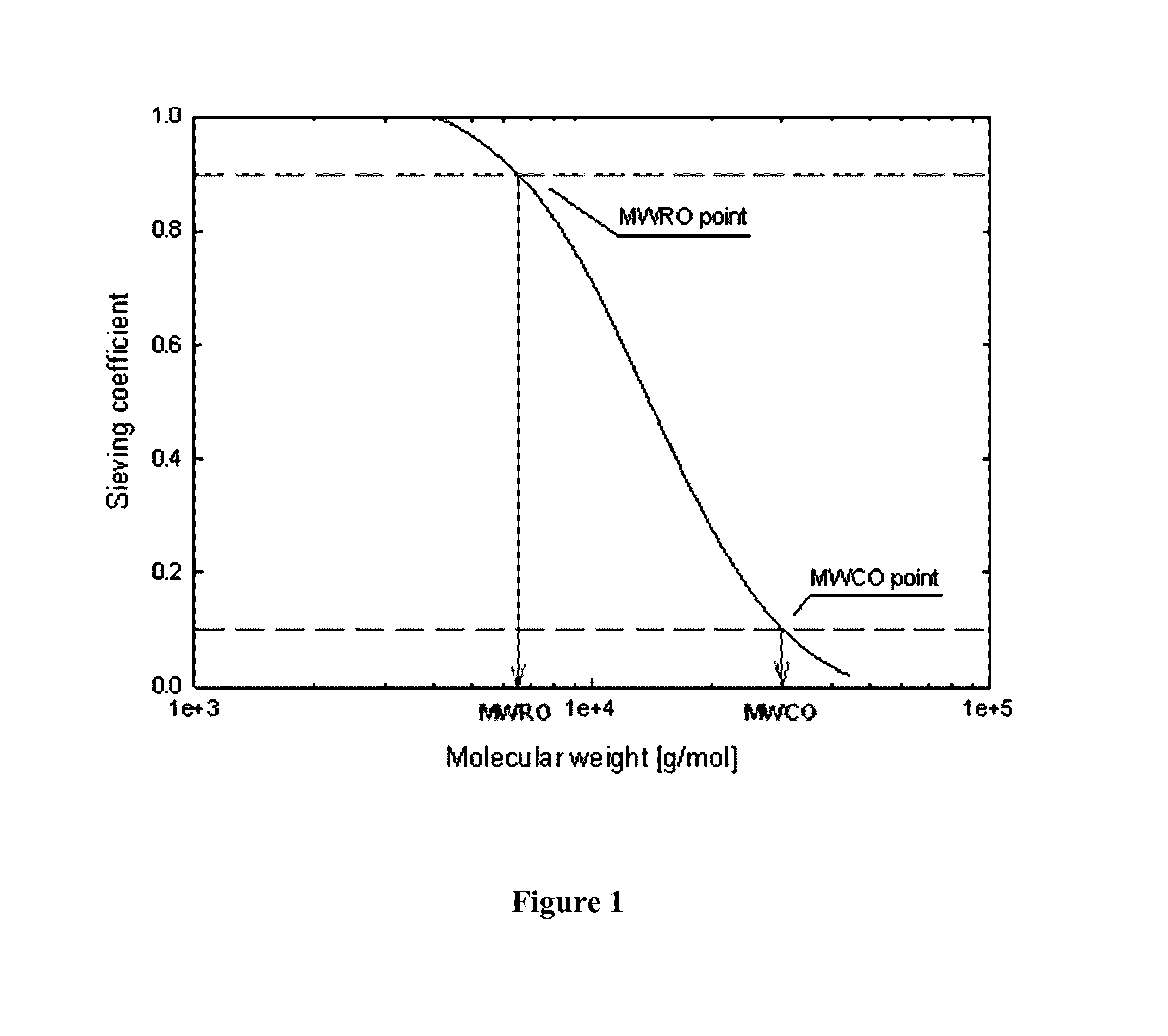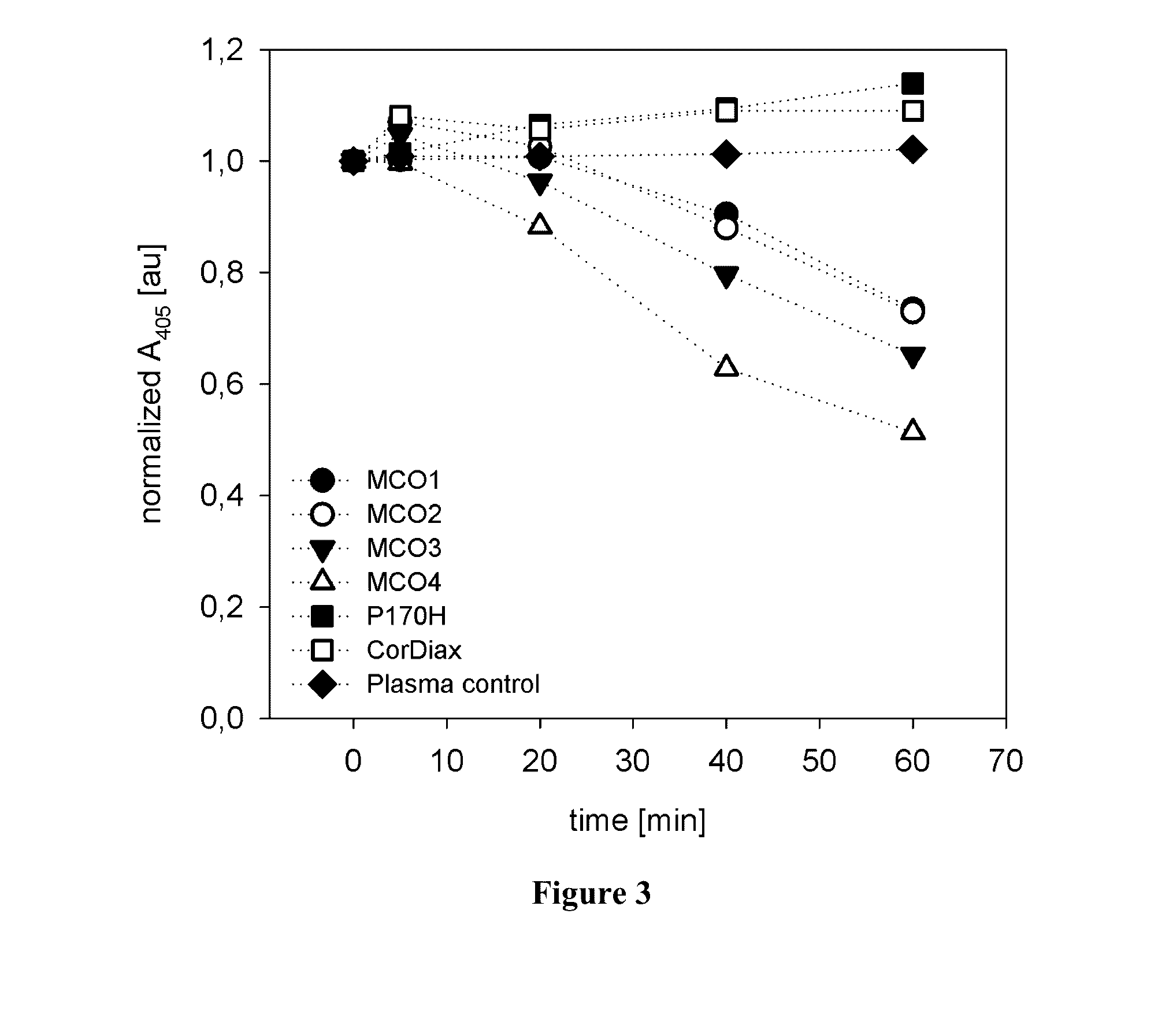Membrane and device for treating hemolytic events
a membrane and hemolytic technology, applied in the field of membranes for hemolytic events, can solve the problems of affecting the treatment effect of patients, affecting the treatment effect, and affecting the patient's hemolytic status, so as to achieve the effect of effectively addressing acute and/or chronic hemolytic events, high cut-off membranes, and high permeability
- Summary
- Abstract
- Description
- Claims
- Application Information
AI Technical Summary
Benefits of technology
Problems solved by technology
Method used
Image
Examples
example 1
Materials and Methods Used for Simulated Dialysis Treatments with Blood or Plasma
1.1 Dialyzers
[0075]The dialyzers used in the simulated treatments were the following: septeX 1.1 m2 (Gambro Dialysatoren GmbH, Hechingen, Germany), Polyflux 170H, 1.7 m2 (P170H) (Gambro Dialysatoren GmbH, Hechingen, Germany), four high-flux dialyzers with extended permeability which were prepared in accordance with PCT / EP2015 / 052364 (1.8 m2, herein referred to as MCO1-4; Gambro Dialysatoren GmbH, Hechingen, Germany), and FX CorDiax80 1.8 m2 (Fresenius Medical Care, Bad Homburg, Germany). Within the different types of MCO prototypes the permeability increased from MCO1 to MCO4. MCO 4 comprises a membrane which was prepared according to Example 1.1 of PCT / EP2015 / 052364. MCO 1 through 3 are based on membranes with the same recipe and the same spinning conditions, with the exception of the temperature chosen for spinning head (SH) and spinning shaft (SS), i.e. 56° C. (SH) and 53° C. (SS) for MCO 1, 57° C. (...
example 2
Hemoglobin Clearance of septeX in Blood and Plasma
[0086]Simulated dialysis treatments with septeX™ were conducted on a Prismaflex monitor using whole blood or plasma, and the plasma absorbance was measured at 405 nm at defined times. The plasma absorbance at the beginning of the experiment was normalized to a value of 1, and the remaining values for each experiment were related to this starting value. FIGS. 2A-2B show the time course of the plasma absorbance under various test conditions. Photographs of the plasma samples taken from the run using whole blood are shown at the bottom of FIG. 2B. When the simulated treatments were performed in the absence of CPH, the plasma absorbance at 405 nm was decreased by approximately 10% (“plasma control” in FIG. 2A). This decrease in absorbance cannot specifically be related to the decrease in CPH. Therefore, plasma control runs were taken as a baseline for the following CPH clearance calculations based on the variations of the plasma absorban...
example 3
Hemoglobin Clearance of High-Flux Dialyzers in Plasma and Blood
[0088]Simulated dialysis treatments with high-flux dialyzers were conducted on an AK 200 Ultra monitor using plasma and blood. The plasma absorbance at 405 nm was measured at defined times. The plasma absorbance at the beginning of the experiment was normalized to a value of 1, and the remaining values for each experiment were related to this starting value. Time courses of the plasma absorbance for the different tested filters are shown in FIG. 3 (tests using plasma) and FIG. 4 (tests using whole blood). When the simulated treatments were performed in the absence of CPH, the plasma absorbance at 405 nm remained constant (“plasma control” in FIG. 3). Therefore, absorbance changes could be related directly to decreases in CPH. In the case of CorDiax and P170H, there was a slight increase in the absorbance over time; however, for the MCO-type filters, the absorbance at 405 nm steadily decreased. CPH clearances were calcula...
PUM
| Property | Measurement | Unit |
|---|---|---|
| concentration | aaaaa | aaaaa |
| concentration | aaaaa | aaaaa |
| concentration | aaaaa | aaaaa |
Abstract
Description
Claims
Application Information
 Login to View More
Login to View More - R&D Engineer
- R&D Manager
- IP Professional
- Industry Leading Data Capabilities
- Powerful AI technology
- Patent DNA Extraction
Browse by: Latest US Patents, China's latest patents, Technical Efficacy Thesaurus, Application Domain, Technology Topic, Popular Technical Reports.
© 2024 PatSnap. All rights reserved.Legal|Privacy policy|Modern Slavery Act Transparency Statement|Sitemap|About US| Contact US: help@patsnap.com










